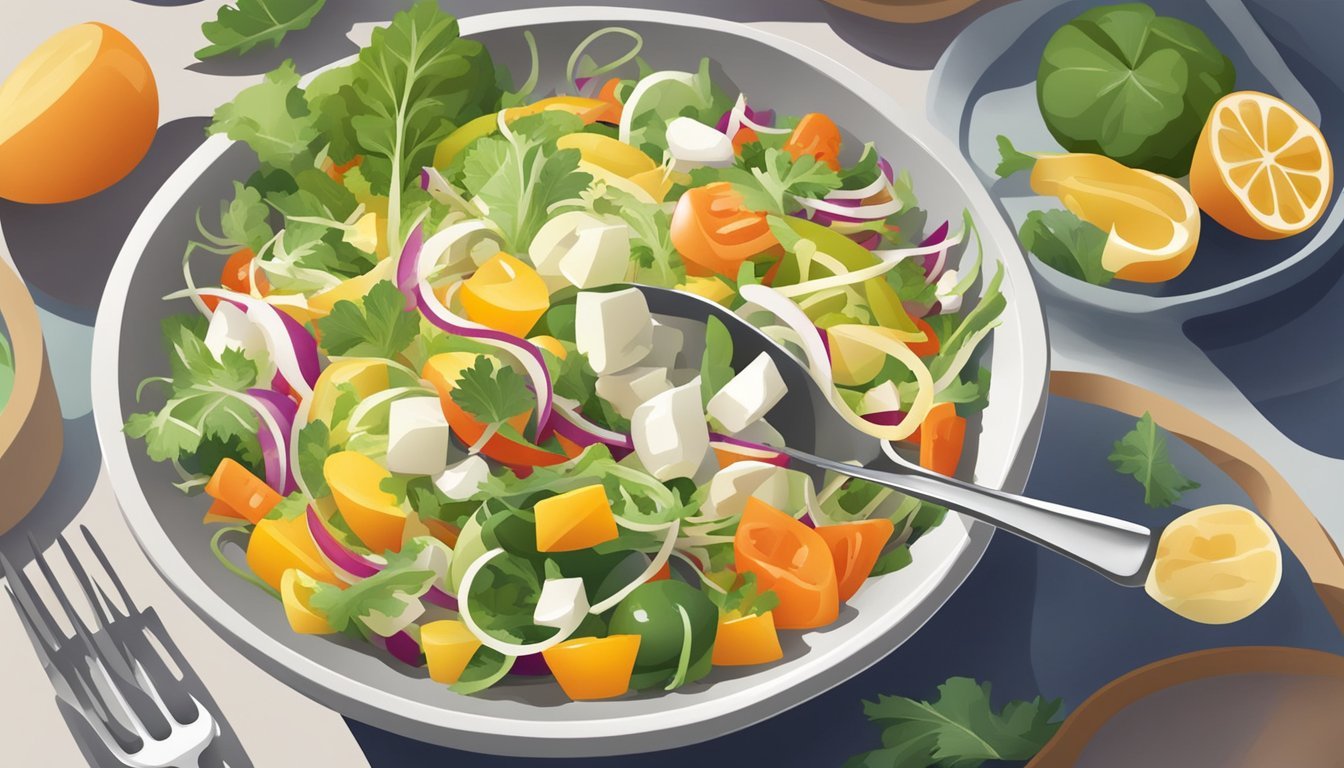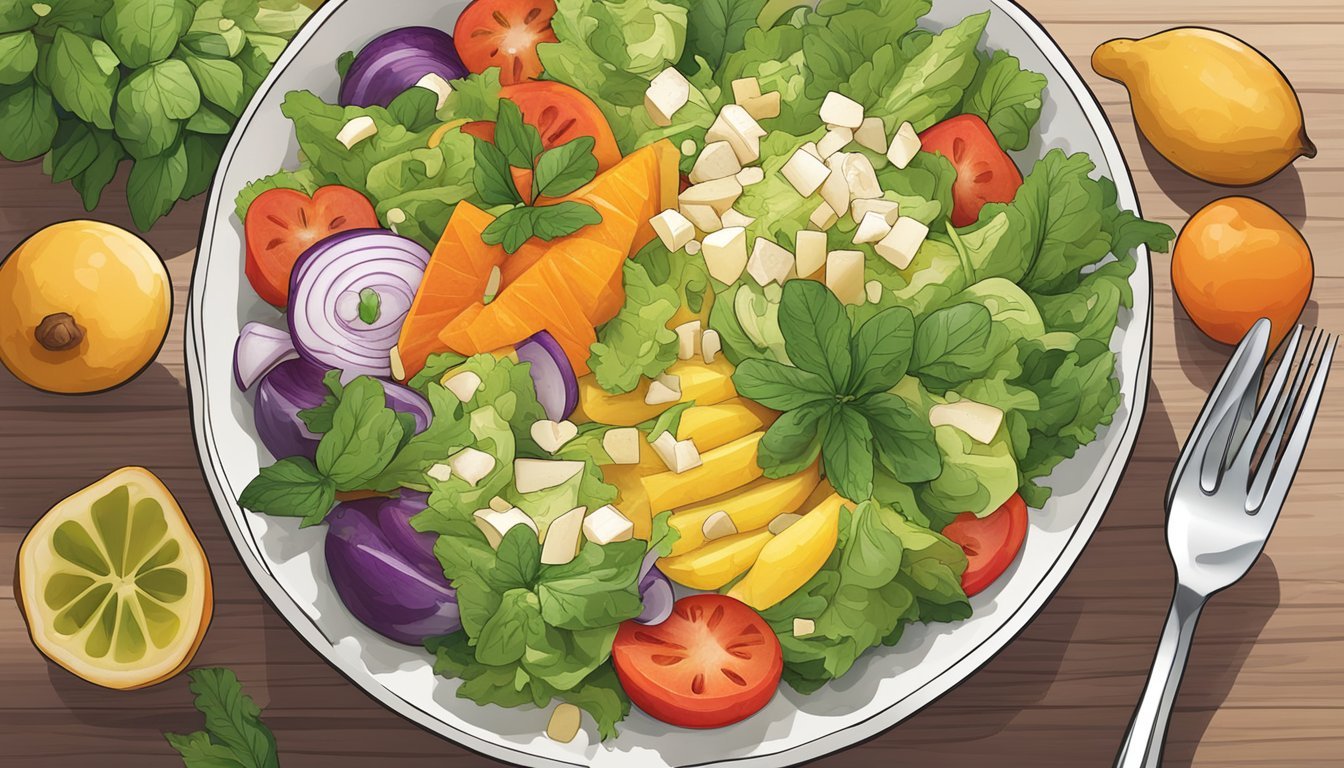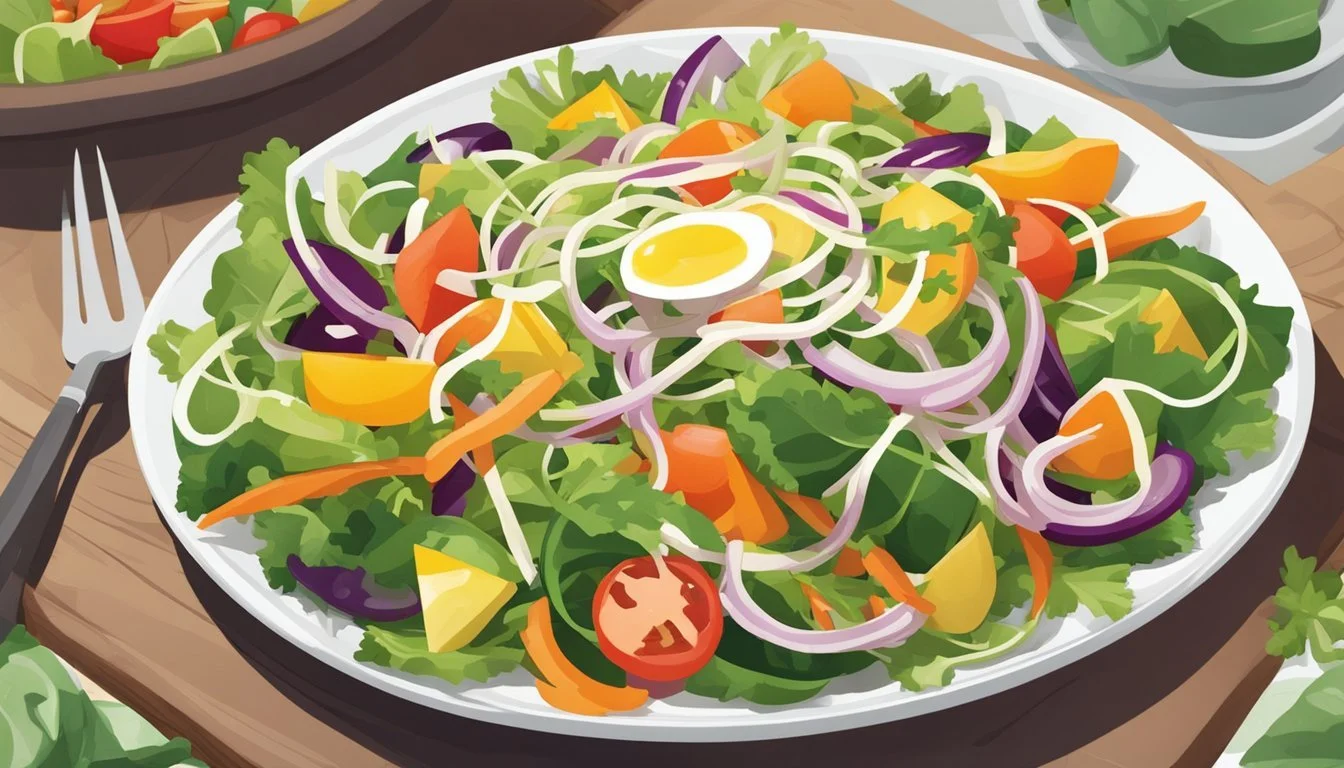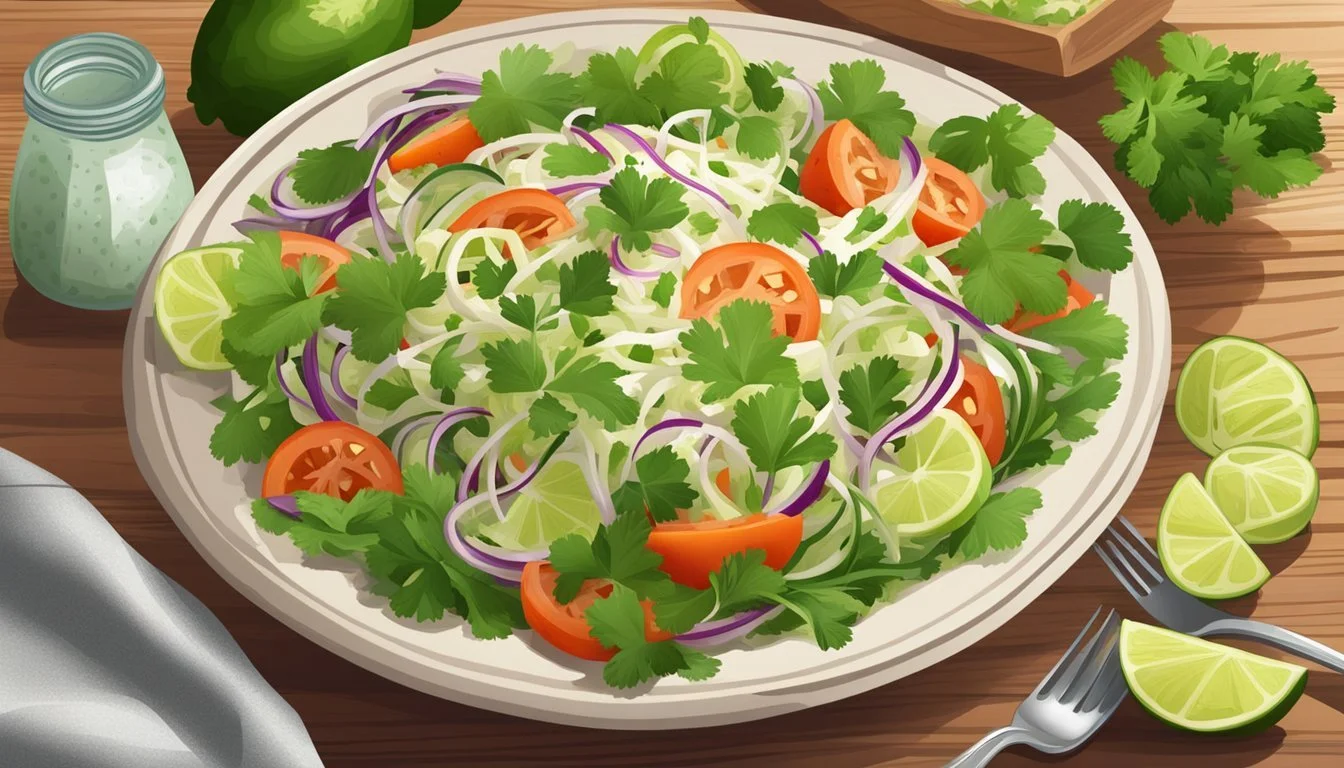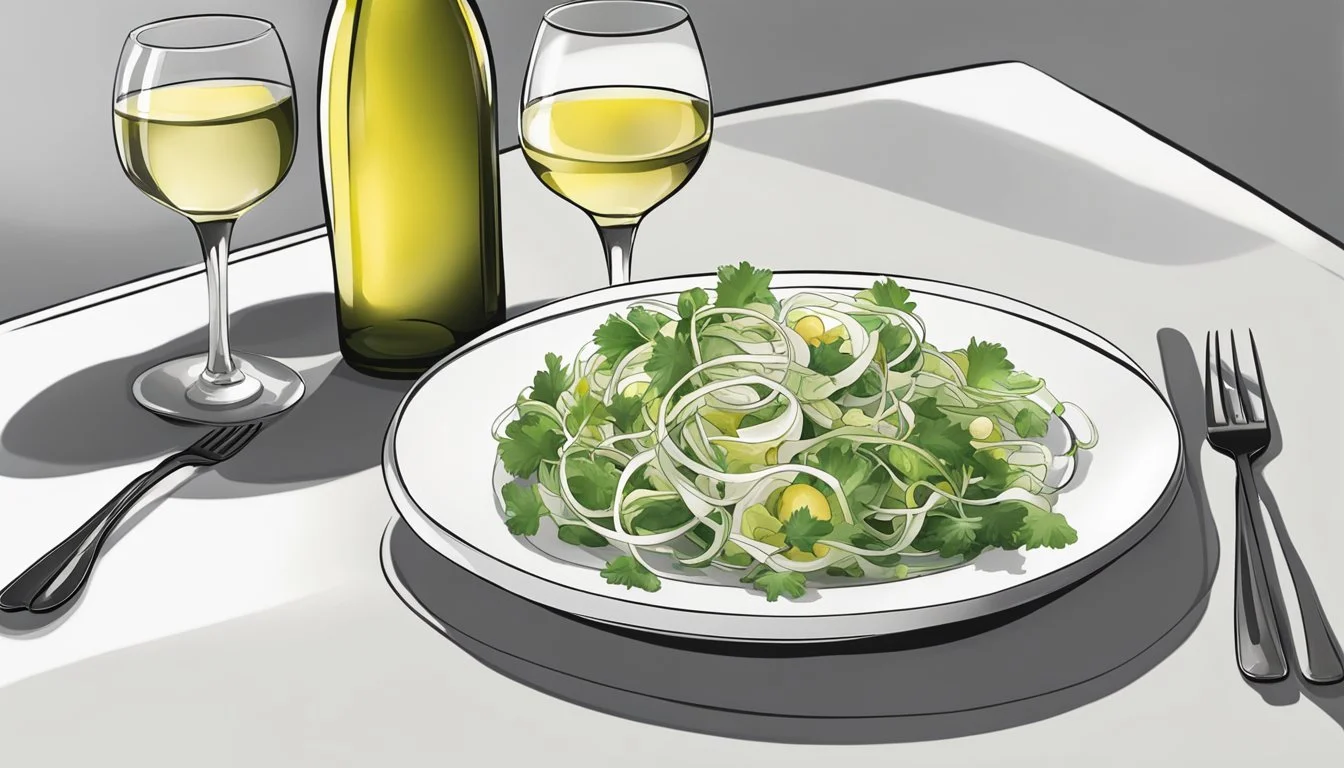How Do You Eat a Jicama Salad?
A Step-by-Step Guide to Enjoying this Crunchy Treat
Eating a jicama salad is a refreshing way to enjoy this root vegetable, often known for its crisp texture and sweet, nutty flavor. Jicama, native to Mexico, is a versatile ingredient that can be eaten raw or cooked. Its unique taste and water content make it particularly appealing for cool, light dishes, (What wine goes well with light dishes?) especially during summer months. When it comes to preparing a jicama salad, the approach is straightforward: the jicama is peeled, then either julienned or chopped into bite-sized pieces, depending on preference.
A jicama salad often incorporates a variety of colorful vegetables and fruits to complement the jicama's mildly sweet taste. Bell peppers (What wine goes well with bell peppers?), red onions, cucumbers (how long do cucumbers last?), and oranges are common additions, creating a vibrant medley of flavors and textures. The tang of lime juice frequently serves as a dressing, adding a zesty note that enhances the overall freshness of the dish. Seasonings such as cayenne pepper, paprika, and salt are sprinkled to taste, balancing the sweet and citrus elements with a hint of spice.
This dish not only stands out for its flavor profile but also for its health benefits, as jicama is rich in important nutrients like vitamin C. A jicama salad can be a nutritious side or a light standalone meal, making it a favored choice for health-conscious individuals seeking a satisfying yet wholesome option. Its cool crispness and ease of preparation solidify its status as a staple for summer gatherings and everyday nutrition.
Selecting and Storing Jicama
When preparing a jicama salad, selecting a fresh, ripe jicama and storing it properly ensures maximum flavor and texture. It is essential to choose the right jicama at the grocery store and understand the best storage practices to keep it fresh until ready for use.
Choosing the Right Jicama
When at the grocery store, one should look for jicamas that are firm and free of bruises or blemishes. The skin should be dry and papery, and the root should feel heavy for its size, indicating it is juicy and fresh. It is preferred not to select roots that have wet or soft spots.
Storage Tips
To store a jicama, first, ensure it is dry as moisture can lead to spoilage. In the refrigerator, jicama will stay fresh for about two weeks. It should be placed in a plastic bag and stored in the crisper drawer to maintain humidity levels. If jicama is cut, it can be stored in an airtight container or a sealable freezer bag to prolong its freshness.
Preparation Basics
Before indulging in the crisp freshness of a jicama salad, one must master the preparatory steps. Ensuring that the jicama is clean, properly peeled, and cut not only impacts the salad's aesthetic but also its textural balance.
Cleaning and Peeling
The very first step in preparing jicama for a salad is to clean the root vegetable thoroughly under running water to remove dirt. Once cleaned, the peeling begins. A sharp knife or a vegetable peeler can be utilized for this task. It's important to remove the tough brown skin, which is inedible, to reveal the white, starchy flesh inside.
Tools: Sharp knife or vegetable peeler
Process:
Rinse the jicama under cool, running water.
Peel off the brown skin using your chosen tool.
Cutting Techniques
After peeling, the jicama should be diced into consistent bite-sized pieces for even distribution in the salad.
Tools Needed: Sharp knife
Methods:
Cubing: For a classic look, the peeled jicama can be sliced into slabs, then into sticks, and finally into cubes.
Sticks: For a more casual salad, jicama can be cut into thin sticks, similar to the cut of matchstick carrots.
By sticking to these preparation basics, the jicama will be ready to be combined with other ingredients, ensuring a delightful crunch in every bite of the salad.
Jicama Salad Ingredients
Crafting a refreshing jicama salad involves a blend of crisp vegetables and fruits, complemented by a zesty dressing and a variety of seasonings and add-ons to elevate the flavor profile. The ingredients listed not only provide a symphony of flavors but also a bounty of nutrients.
Vegetables and Fruits
Jicama: A medium-sized jicama, peeled and sliced into strips, is the star ingredient.
Bell Peppers: Red or multi-colored bell peppers add color and crunch.
Red Onion: Thinly sliced for a sharp, piquant taste.
Cucumber: Peeled and chopped to confer a refreshing crunch.
Mango: One ripe mango, peeled and cubed, imparts a tropical sweetness.
Tomato: Optional addition of diced tomatoes for a juicy burst.
Avocado: Some recipes incorporate avocado for its creamy texture.
Carrots: Julienned carrots offer an earthy sweetness and a vibrant color.
Dressing Components
Lime Juice: Freshly squeezed lime juice is essential for its citrus tang.
Cilantro: (how long does cilantro last?) Chopped cilantro infuses the salad with a distinct herbal freshness.
Apple Cider Vinegar: Some variations include apple cider vinegar for a tangy kick.
Honey: A drizzle of honey balances the acidity with natural sweetness.
Seasonings and Add-ons
Salt: Season generously to taste.
Cayenne Pepper: Just a pinch for a subtle heat.
Paprika: Often used to sprinkle over the salad for additional depth of flavor.
Pumpkin Seeds: Toasted pumpkin seeds add a nutty crunch to the final dish.
Nutritional Value
Jicama salad is distinguished by its high nutritional value, delivering a myriad of essential vitamins and minerals alongside macronutrients crucial for a balanced diet. The root's crunchy texture is not just satisfying to bite into but comes packed with dietary advantages with minimal calories.
Macronutrients
In terms of macronutrients, jicama is primarily composed of water, making it low in calories—typically around 46 calories per cup. It's a great source of dietary fiber, with approximately 6.4 grams per serving, which aids in digestion and satiety. Jicama contains a modest amount of protein, about 1 gram per cup, and is virtually fat-free, with only 0.1 grams per serving. The carbohydrate content is about 11 grams per cup, and due to its high water and fiber content, it has a low impact on blood sugar levels.
Calories: 46 per cup
Protein: 1 g
Fiber: 6.4 g
Fat: 0.1 g
Carbohydrates: 11 g
Water: High content
Vitamins and Minerals
Jicama is rich in vitamin C, supplying 44% of the recommended daily value per cup, which supports immune function and skin health. It also contains essential minerals such as potassium and magnesium, which are vital for heart health and bone strength, respectively. Although lower in content, jicama provides small amounts of calcium and iron—minerals important for maintaining healthy bones and blood.
The root vegetable is low in sodium, with just 5 milligrams per serving, which makes it a heart-healthy choice. The presence of both saturated and unsaturated fat is minimal, making it a predominantly cholesterol-free food.
Vitamin C: 26.3 mg (44% DV)
Potassium: Not specified
Magnesium: Not specified
Calcium: Not specified
Iron: Not specified
Sodium: 5 mg
Note: Specific values for potassium, magnesium, calcium, and iron are not provided, but they are present in varying quantities. Daily Value percentages are based on a 2,000 calorie diet.
Assembling the Salad
To assemble a jicama salad, one carefully arranges the fresh ingredients to achieve a blend of sweet and crunchy textures while skillfully incorporating the dressing for a balanced flavor.
Layering Ingredients
When creating a jicama salad, one starts by placing the base ingredients like cubes of crisp jicama, and a variety of other vegetables such as sliced bell peppers and cucumber in a large serving bowl. If including fruits such as orange sections for sweetness, these are added atop the other components. It's important to season each layer gently with salt and pepper as they are added to enhance their natural flavors.
Mixing and Tossing
After layering, one uniformly sprinkles the salad with olive oil or a preferred vinaigrette. Using two large spoons or salad tongs, they then gently toss the salad to ensure that each piece of jicama and accompanying ingredients is lightly coated in the dressing and seasoning. This not only helps to distribute the flavors but also keeps the salad from becoming soggy. The final touch is a generous seasoning with salt and pepper, according to taste.
Serving and Presentation
When serving a jicama salad, one should consider both the visual appeal and the practicality of the dish. Presentation enhances the overall eating experience and caters to both the aesthetic and the flavor profile of the salad.
Plating Techniques
For an effective presentation, one can plate the jicama salad in a clear, wide bowl or on a platter to showcase its vibrant components. Distribute the jicama evenly to highlight its crisp texture against the softer elements of the salad, such as tomatoes or cucumbers. When catering to multiple servings, one might use individual plates, serving an equal portion of the salad to each guest, ensuring that every plate receives an array of colors and textures.
Garnishing and Finishing Touches
The final step in presenting a jicama salad is the garnishment. This final touch should not only contribute to the visual appeal but should also complement the salad's flavors. A sprinkle of fresh herbs like cilantro or parsley adds a pop of color and a burst of freshness. For an extra dimension of flavor, a light dusting of spices such as paprika or cayenne can be added according to personal preference or dietary considerations, such as vegan or allergy restrictions. If the jicama salad is accompanying other dishes as a side, consider its position on the table and present it along with complementary condiments like salsa or a light dip. It's crucial to add any garnishing right before serving to maintain its freshness and texture.
Variations and Alternatives
In crafting a jicama salad, one has the flexibility to explore various added ingredients for unique flavors or accommodate dietary restrictions without compromising the dish’s refreshing quality.
Additional Flavors and Textures
To enhance the flavor profile of jicama salad, one can incorporate fruits and vegetables typical of Mexican cuisine. Jicama pairs well with the sweetness of pineapple or orange segments, offset by the heat from minced jalapeño peppers. For added texture, roasted corn kernels offer a delightful crunch and smokiness. Here’s a quick guide:
Sweetness: Pineapple chunks, orange segments, a drizzle of honey
Heat: Thinly sliced jalapeño peppers (deseeded for less heat)
Freshness: Chopped parsley or cilantro for an herbal note
Texture: Corn kernels (preferably roasted for a smoky flavor)
Incorporating these ingredients will not only enrich the salad but also stay true to its roots in Mexican food culture, where jicama is often used as a refreshing side dish or snack.
Dietary Modifications
For those with specific dietary needs, jicama salad can be easily modified without sacrificing taste. One may substitute sugar with natural sweeteners like honey for a healthier alternative. For a low-calorie version, omit sweet fruits and opt for citrusy dressings. Here are suggestions for common dietary adjustments:
Low-calorie option: Use a dressing of lime juice and a touch of honey; skip higher-calorie fruits.
Low-sugar diet: Substitute sugar with natural sweeteners like honey, or use fresh herbs to add flavor without sugar.
By adjusting ingredients, one can cater to varying dietary preferences and requirements, making jicama salad a versatile dish for many.
Culinary Context
Jicama, a root vegetable native to Mexico, offers a refreshing crunch in salads. Its versatility and mild flavor allow it to blend seamlessly into a variety of culinary traditions, providing a unique textural element.
Jicama in Mexican Cuisine
In Mexican cooking, jicama is frequently enjoyed as a raw snack, seasoned with lime juice and chili powder. It's a crisp complement in Pico de Gallo, often alongside tomatoes, onions, and cilantro. A classic jicama salad might include slices of this crunchy root with oranges, jalapeños, and a dressing of lime juice. Jicama's firm texture holds up well against the bold flavors common in Mexican food, making it a perfect addition to dishes such as tacos and salads.
Ingredients commonly paired with jicama in Mexican cuisine:
Lime
Chili powder
Cilantro
Tomatoes
Oranges
Global Inspirations
Jicama's culinary use extends beyond Mexican borders, becoming a canvas for a range of flavors in global cuisines. Jicama's gentle flavor allows it to absorb dressings and spices, making it an ideal ingredient for inventive salad combinations. Central American salads might incorporate jicama with avocado, black beans of the bean family, and bell peppers, while an Asian-style jicama salad could feature a dressing with hints of sesame oil and ginger, paired with red cabbage or carrots for color and additional crunch.
Global salad inspirations featuring jicama:
Central American: Jicama, avocado, black beans, bell peppers, corn
Asian-inspired: Jicama, sesame oil, ginger, red cabbage, carrots
Tips and Tricks
When preparing a jicama salad, attention to safe handling and cooking methods will ensure that the dish is delicious and maintains its integrity. Storing jicama correctly can significantly extend its freshness and flavor, making your salads a consistent hit.
Safe Handling and Cooking
Proper preparation of jicama begins with peeling its fibrous skin to reveal the starchy, edible interior. For a jicama salad, no cooking is required, as it's typically enjoyed raw to savor its crisp texture and mildly sweet taste. However, if one chooses to incorporate cooking methods, such as roasting or sauté, it's important to note that extra virgin olive oil can enhance flavor while keeping the dish within vegan guidelines. One should ensure that any additional vegetables or ingredients are also prepared safely, either by stir frying in a skillet over medium heat or mixing them raw into the salad.
Prep time: Aim to prepare your ingredients for the salad, including the jicama, in advance for more efficient assembly.
Total time: While jicama doesn't require cooking for a salad, additional ingredients such as sautéed bell peppers or roasted nuts can add to the overall time needed.
Maximizing Shelf Life
Jicama’s shelf life can be maximized with proper storage techniques. It should be stored in a cool, dry place before being cut, and kept in the refrigerator afterwards. Storing peeled and cut jicama in water can prevent browning:
Before cutting: Store whole jicama in a cool, dark place.
After cutting: Submerge in water or cover with a damp paper towel, and refrigerate.
Note: Moisture can lead to spoilage; thus, any excess water should be drained, and the jicama should be dried before adding it to the salad. This ensures the best texture and freshness when mixed with other ingredients such as cucumbers, red onions, and citrus dressing.
Health Considerations
When incorporating jicama into salads, one should consider its nutritional benefits and potential dietary implications. Jicama is a root vegetable full of dietary fiber and is low in calories, making it a beneficial addition to various diets.
Allergies and Sensitivities
Individuals should be aware of any personal allergies or sensitivities before consuming jicama. Although allergies to jicama are uncommon, they should consult a healthcare provider if they experience symptoms such as itching or gastrointestinal discomfort after consumption. As jicama is often consumed raw, its cleanliness is crucial to prevent any foodborne illnesses.
Weight Management and Diet
For those managing weight or adhering to specific diet plans, jicama is a suitable choice due to its low-calorie content and high fiber.
Caloric Content: Jicama is low in calories, with a 100 g serving containing approximately 38 calories. This makes it a smart choice for calorie-conscious individuals.
Fiber: High in dietary fiber, jicama can promote a feeling of fullness and aid in digestion. The fiber content also supports cardiovascular health by potentially lowering cholesterol levels.
Minerals: Jicama provides valuable minerals such as potassium and magnesium, essential for various bodily functions.
Dietary Restrictions: Jicama suits many dietary restrictions as it is naturally gluten-free, nut-free, and free from seeds, aligning well with vegetarian, vegan, and paleo diets.
As a nutritious snack or salad component, jicama can play a pivotal role in a balanced diet, promoting overall health while satisfying dietary needs and preferences.
Complementary Dishes and Pairings
Jicama salad, known for its refreshing crunch and versatility, pairs well with a variety of main courses and beverages. It often brings a light balance to rich and hearty dishes.
Matching with Main Courses
Mexican Cuisine: Jicama salad is a natural fit alongside Mexican dishes. It can complement proteins such as:
Grilled chicken or fish, especially when seasoned with chili powder or other Mexican spices.
Tacos or fajitas, where the refreshing crunch of jicama contrasts the soft texture of tortillas.
Starchy Sides: Due to its refreshing nature, jicama salad balances out starchy, heavier dishes like:
Potato-based meals, providing a lighter counterpoint to the denseness of potatoes.
Rice dishes, where the crispness of jicama contrasts the soft grains.
Salads and Slaws: To create a diverse salad plate:
Mix jicama with cucumbers and red bell pepper for a vibrant slaw that complements other salads.
Drinks and Beverages
Pairing with Drinks: When choosing beverages to serve with jicama salad, consider:
Citrus-based drinks, such as limeade or lemon-infused water, to enhance the salad’s zesty flavors.
Iced herbal teas, offering a subtle flavor that doesn’t overpower the salad's fresh taste.
Alcoholic Options: For those preferring an alcoholic beverage:
Light beers or a crisp white wine like Sauvignon Blanc can be an excellent match, mirroring the salad’s lightness.
A margarita or a paloma could also be a good pairing, especially for a Mexican-themed meal.
After Preparation Care
After preparing a jicama salad, the freshness and crispness of the ingredients are paramount. Maintaining the quality of the salad requires proper storage and the potential for repurposing any leftovers.
Storing Leftovers
Leftover salad should be stored in an airtight container and placed in the refrigerator to maintain freshness. It should be noted that jicama retains its crisp texture well, making it ideal for storage. However, to prevent sogginess, separate any undressed salad components if possible. The salad will stay fresh in the refrigerator for up to two to three days. Any dressings should be stored separately to prevent the salad from becoming soggy and to preserve the distinct crunch of jicama.
Reusing and Repurposing
Jicama's versatility allows it to be repurposed beyond its initial use in a salad. Consider the following options for any leftover jicama:
Transform into Snacks: Slice leftover jicama into sticks to create a crunchy alternative to chips.
Incorporate into Other Dishes: Dice any remaining jicama and add it to stir-fries or soups for an added crunch.
Creating a New Meal: Combine jicama with other leftover vegetables and proteins to devise a new salad for the following day, ensuring nothing goes to waste.
By implementing these strategies, the life of a jicama salad can be extended, and the tuber's utility maximized.

